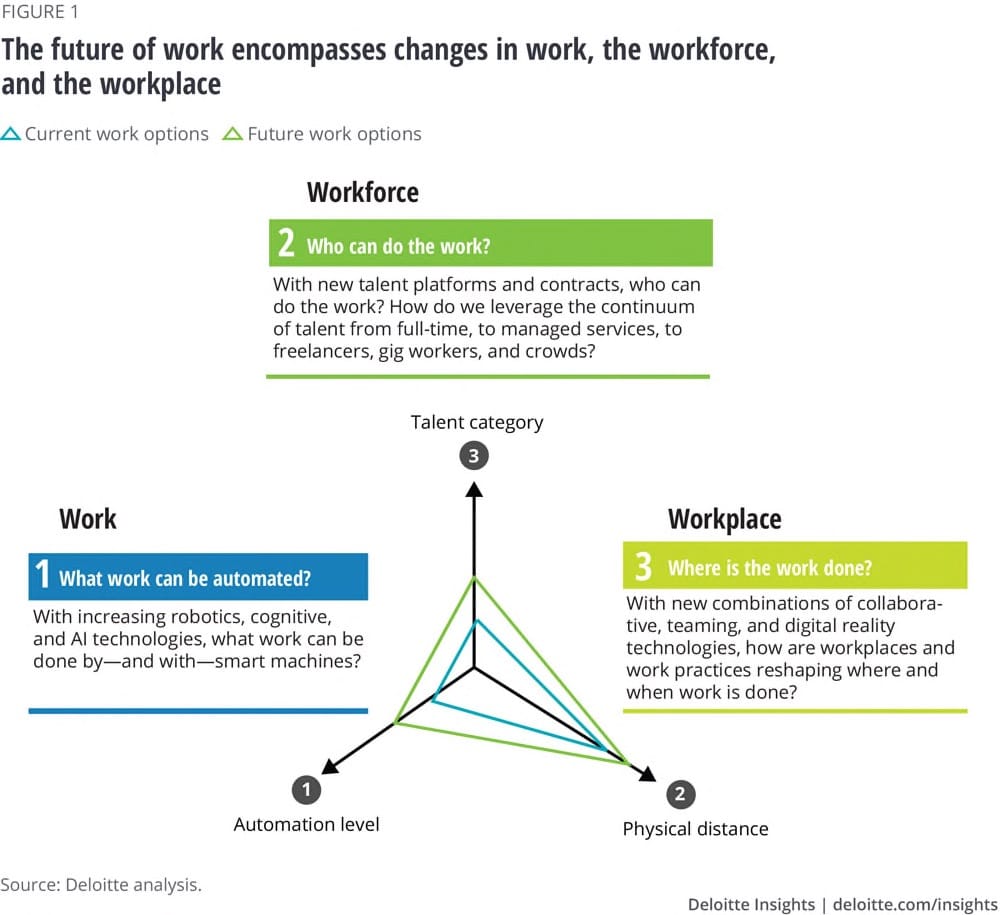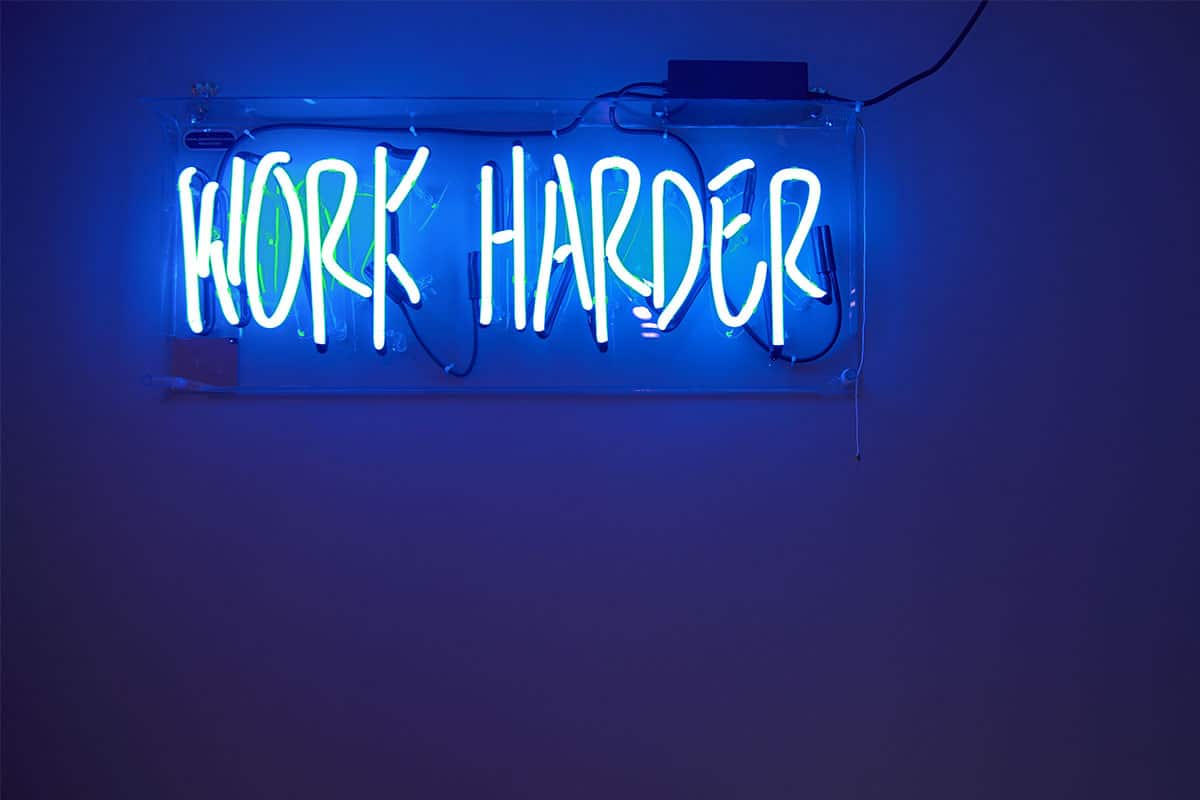What is the Role of Work in the Future? With the current discussions on Digital Transformation, a lot of ink is being put in trying to define concepts as “The Future of Work”, or “The Work of the Future”. I’m more interested in questioning what key trends are shaping the role that work will have in the future, and this post will focus on this. I do think that there is more than just reasoning in terms of Role of Work in the Future. But I leave this to other posts on this blog (for example as I discuss the key skills needed in the future of work).
Note: I’ve been expanding on the concept of The Meaning of Work in a full series of posts and articles. Feel free to browse through it.
The origins of the topic
Since the beginning of organisational theories, social scientists and managers kept struggling on how much operations should be centralised or decentralised. This topic has been the big conundrum of most of the organisational theories for a lot of time. It is in this period that the role of HR has been framed to manage labour or work within the organisation.
At the beginning of the seventies, the above discussion has added a new aspect: that of delocalisation. Through off-shoring of some production activities, the traditional organisation was effectively carving out some activities it would typically manage, attributing these to entities which were not just part of a conventional sourcing relationship.
With the mid of the eighties, a new cost-cutting exercise meant that more functions were being outsourced, giving a path to an entirely new set of arrangements with outsourcing partners. New forms of contracts also allowed to rent labour through different means. This means that HR (and the organisation it represents) very rarely controls the work that is involved in the production of goods and services by the company.
Fast-forwarding to today, companies have to manage at least eight different sources of labour. Essentially this is how we, today, get shit done.
- Employees. This is still the primary source of work for most organisations, although not necessarily of value. We again reason in terms of full-time and part-time work, and the concept of working time still dominate this relationship.
- Independent contractors. These have always been present, but in the past were relegated to very specialised roles (think lawyers). It has become more and more an option, up to the point that is identified as a characteristic of the so-called third industrial revolution. Today they represent a big part of the employment-population, up to the point that a lot of legislative and judiciary work works on their status definition.
- Gig workers. With the recent wave of digital platforms offering service, a new category of worker has established itself. Gig Workers typically take short term assignments or project work, but the definition is flexible.
- Outsourcers. As mentioned above, it’s another way that the Third Industrial Revolution as made many companies “lean”: the outsourcing of entire processes are typically done for efficiency or labour arbitrage reasons.
- Investment in Start-ups. This is becoming a more common trend for companies looking for new and alternative talent and can take many forms, from simple alliance to full buy-in. It’s often seen also as a way to diminish risk.
- Volunteers/community. Think of the number of Linux developers. No real relationship with any company, but most companies that distribute Linux builds (think of redHat) profit extremely from this volunteering work. Also, a lot of crowdsourcing innovation can start from here.
- Robotics. Not a new trend, this is about the automation of physical work. A lot of the efficiency gains int he 90s, across a broad set of industries, came through robotic automation.
- Smart automation. This is the newest concept of automation, based on artificial intelligence and machine learning. It can substitute a lot of highly repetitive tasks and rule-based work, also augmenting existing employee capabilities.
Within this framework, one of the immediate consequences is a diminished role of HR. Traditionally focused only on employees, HR has given up its core focus of managing labour for the organisation.
For the company as a whole, the above means becoming a distributed organisation, where the coordination of so many different ways to collaborate, becomes an arduous task, often without one function that really owns this task.
What’s the role of Work in the Future?
In the entire discussion about the Role of Work in the Future, a lot of attention has been drawn on how to integrate the multiple shapes that work can take today. In this, the research was done by Deloitte on redefining work, workforce and the workplace helps a lot by providing a framework of reference.

Figure 1 shows the model on three axes and looks at work from multiple perspectives.
- Level of Automation (what work can be automated?)
- Talent Category (who can do the work?)
- Physical Distance (where is the work done?)
It’s the combination of these three factors (or forces as Deloitte defines them) that will influence even more the way organisation will get things done. And I believe that the eight models we have seen in the first part of this post will probably become more and more complex over time.
What’s going on is that work is being disconnected from jobs, and jobs and work are being disconnected from companies, which are increasingly becoming platforms.
Thomas Friedman
Is there a role for HR?
What is the role of HR in this? I think that the challenge posed by the above is the critical challenge for HR. Our entire profession has been focused on designing jobs and finding and developing talent to do the work associated with that job. Too often we ourselves feel we’re not ready to do the rest, including the bigger task of designing organisations.
Part of the reason is that we keep associating ourselves only with the concept of employees. And in many companies, HR is associated with being the voice who keeps arguing on the dangers of having new and multiple forms of work, due to the legal risks. I’m not saying that legal risks should not be managed, on the contrary. But the fact is that labour law is lagging in development in many countries, and although political answers are expected to ensure that innovative ways of working are not merely created to diminish wealth, it’s not by hiding the head in the sand that we serve the business needs of our organisations.
Reinventing Talent
One of the possible answers is to utilise another concept that Deloitte has developed in the past, the Talent Continuum. As seen above, work is not done anymore only by traditional employees. We need to consider multiple types of relationship.

At the origin of many of these different types of relationship, there was often a pure Cost Consideration, sometimes made more acute by accounting rules.
Today there are other elements to consider: risk, availability of resources, integration opportunities and scale. For example, for many start-ups, employment is not an opportunity; they need to resort to crowdsourcing to derive ideas. From a talent perspective this need to change our view of the employee life cycle from the traditional “attract, develop, and retain” model to one where the key questions are how organisations should access, curate and engage workforces of all types. This, however, requires a complete rethinking of all Talent Models. Continuing to concentrate our talent tools only to a segment of the workforce, is a losing strategy.
A new paradigm for HR
Michael Armstrong writes that the overall purpose of human resources (HR) is to ensure that the organization is able to achieve success through people. If this holds true, HR needs to become something completely different than it is today. I’ve already mentioned this: if we keep chasing the idea of becoming business partners, yet we only concentrate on employees, we are just putting ourselves in a corner of irrelevance.
HR needs to become the critical advisor in defining the company strategy towards any kind of work relationship. It needs to ensure the company can access the required talent in any shape and form by providing a unifying purpose to the different types of worker.
This means becoming experts in automation, as we need to become advisers on where and how much to automate. It means understanding the role of different types of working relationships, applying new talent models to the entire workforce. It means imaging a future where sh*t gets done in many different alternative ways, that we all need to master.
What do you think?

Cover Photo by Jordan Whitfield on Unsplash

[…] challenged by the idea that “HR is a job for losers“. I have tried to understand where we can still make the difference, which around (re)taking ownership of the relationship between the “work” and the way the […]
[…] one thing that I missed in this book is the effect of this new information technology on the Future of Work. There are some fascinating considerations on Artificial Intelligence (or rather, on the lack of […]
[…] yet supports the bridging of Strategy and Execution. It is interesting to focus the role that work has in this model, in its more ample definition. Choosing how work gets done (for example, is […]
[…] of Work or Work of the Future? I have already been challenging you on this topic. Yet the idea of understanding the challenges of the evolution of work (particularly in a moment […]